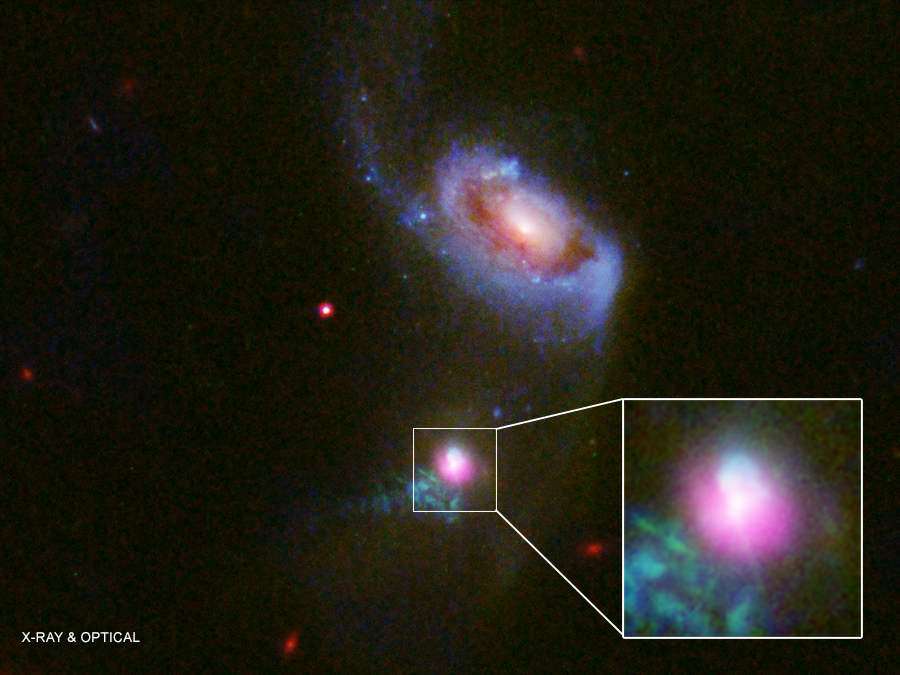Monster Black Hole Unleashes Messy Double 'Burp'
The giant black hole at the center of a distant galaxy has been spotted taking in gas and letting out two mighty "burps" of high-energy particles, lending support to the theory that such galactic cores go through cycles of messy activity.
Researchers presented images of the belching black hole today (Jan. 11) at the American Astronomical Society's winter meeting in National Harbor, Maryland, showing lingering evidence of two burps in a row.
"Black holes are voracious eaters, but it also turns out they don't have very good table manners," Julie Comerford, an astronomer at the University of Colorado Boulder, said during a news conference at the event today. "We know a lot of examples of black holes with single burps emanating out, but we discovered a galaxy with a supermassive black hole that has not one but two burps." [The Strangest Black Holes in the Universe]

Supermassive black holes that lurk at the center of galaxies can have masses ranging from a million to a billion times that of the sun. Although they often lie relatively dormant, they can snap into action when gas comes near, sucking it inward and blasting out some high-energy particles in the process — the "burp." (Note that those particles come from near the black hole's event horizon, but not within its point of no return.)
The supermassive black hole in question lies at the center of a galaxy called SDSS J1354+1327, about 800 million light-years from Earth, and it seems to be making meals of gas released by a companion galaxy. Comerford's team combined images from the Chandra X-ray Observatory and the Hubble Space Telescope to pinpoint the black hole (in X-ray) and two emerging bubbles of gas shocked into motion by the fast-moving particles: one above, and one below. The older burp happened earlier, and the bubble has had time to expand 30,000 light-years from the black hole, Comerford said. The newer burp, by contrast, appears as just a little loop that's made it 3,000 light-years from the black hole.
"This new burp is actually moving like a shock wave — it's coming out very fast, and so it's kind of like a sonic boom of a burp," Comerford said, "whereas the gas to the south shows us an older burp that happens 100,000 years earlier before that newer burp."
Theory held that supermassive black holes would go through a cycle of feasting, burping and then napping for a while, Comerford said, and spotting these belches helps set a pace for that process. While two burps 100,000 years apart may seem like a pretty slow metabolism, it's very fast on cosmic scales.
Get the Space.com Newsletter
Breaking space news, the latest updates on rocket launches, skywatching events and more!
The pace matched computer models of how those interactions would work, Comerford added. In the video below, for instance, from work by Jared Gabor and Frédéric Bournaud of CEA Saclay in France, you're watching a galaxy from the side as burps emerge above and below it.
The black hole Comerford imaged is getting its fuel from a companion galaxy next door — the two are exchanging a stream of stars and gas after recently colliding.
Closer to home, there's evidence that the black hole at the center of the Milky Way burped as well, at least once: In 2010, researchers found bubbles of gas expanding outward from the galactic core, from an event millions of years ago. The pace of such burps suggests that the Milky Way will indeed burp again someday.
"Right now, our galaxy's supermassive black hole is firmly in the nap phase of the feast-burp-nap cycle, but it's just waiting for its next meal to come along," Comerford said. "In the future, it will probably feast and burp once again."
But that galactic burp is nothing to worry about, she told Space.com. "If our Milky Way's black hole became active again, we are far enough away from it that we would be fine," Comerford said. "If our solar system was very close to the black hole, though, we'd be fried."
Email Sarah Lewin at slewin@space.com or follow her @SarahExplains. Follow us @Spacedotcom, Facebook and Google+. Original article on Space.com.
Join our Space Forums to keep talking space on the latest missions, night sky and more! And if you have a news tip, correction or comment, let us know at: community@space.com.

Sarah Lewin started writing for Space.com in June of 2015 as a Staff Writer and became Associate Editor in 2019 . Her work has been featured by Scientific American, IEEE Spectrum, Quanta Magazine, Wired, The Scientist, Science Friday and WGBH's Inside NOVA. Sarah has an MA from NYU's Science, Health and Environmental Reporting Program and an AB in mathematics from Brown University. When not writing, reading or thinking about space, Sarah enjoys musical theatre and mathematical papercraft. She is currently Assistant News Editor at Scientific American. You can follow her on Twitter @SarahExplains.









